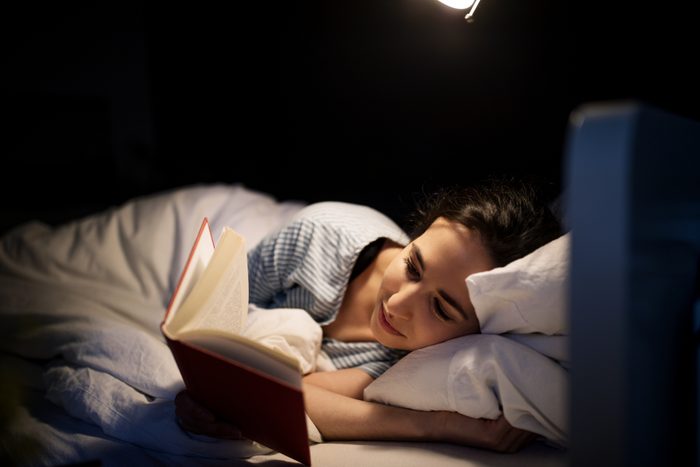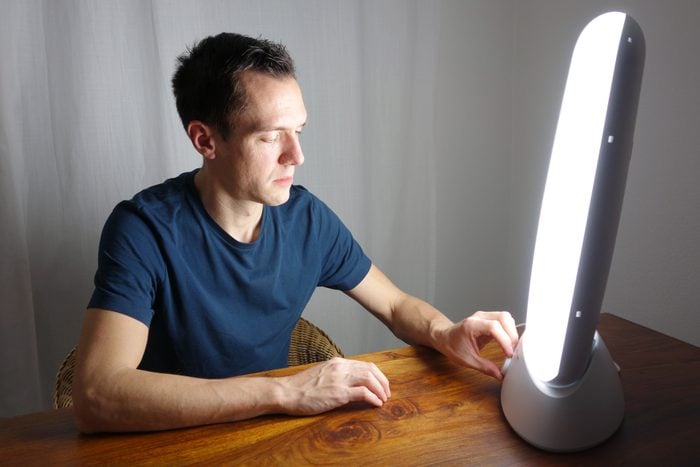
It’s normal for the blues to creep up from time to time in the winter, but it’s estimated that at least 10 million Americans experience what’s known as seasonal depression. One 2015 paper in the journal Depression Research and Treatment noted that seasonal depression, often also referred to as “seasonal affective disorder” or SAD, is marked by symptoms that “center on sad mood or low energy.” Sherri Melrose, the professor of nursing and health studies who authored the paper, says people who are most at risk for seasonal depression “are female, are younger, live far from the equator, and have family histories of depression, bipolar disorder, or SAD.”
But even if you fall outside of those categories and you notice seasonal depression symptoms, it’s very possible you’re not imagining. The National Institute of Mental Health (NIMH) suggests that seasonal affective disorder may be underdiagnosed, with millions of people unaware that they’re dealing with the condition.
In a nutshell, seasonal affective disorder symptoms mirror the symptoms associated with major depressive disorders, but they last for about four or five months out of the year (often starting in the fall and spanning into the winter months—but SAD can occur in summer, too.) The NIMH says that people experiencing winter-pattern seasonal depression tend to oversleep, overeat, and withdraw from their social lives.
11 Things About SAD That Psychologists Wish You Knew
Doctors’ habits to manage seasonal depression
While the underlying causes of seasonal affective disorder aren’t well understood, chronobiologists suspect it’s the shortening length of day that triggers seasonal affective disorder, says Georgia Witkin, PhD, a clinical psychologist and head of patient services development for Progyny. “Our biological clock is reset every day by early morning light,” she explains. It’s this internal clock that synchronizes our sleep, appetite cycles, sex drive, alertness, and mood. So, when it’s dark in the morning and evening due to weather and time change, this can send your biological clock into free fall, she says—along with all the processes it controls.
To keep this internal clock in rhythm and ease your seasonal depression symptoms, Dr. Witkin and other doctors say the following practices can help lighten the mood.
36 Depression Quotes That Capture Exactly What You’re Feeling

Get some natural morning light
When it’s cold and dreary, it can be especially tough to motivate yourself to get outdoors—particularly if you’re feeling more lethargic than usual. But, says Dr. Witkin, “The most-often recommended, non-medication approach [to managing SAD] is getting early morning light.” She continues: “It doesn’t need to be in the sunshine, but if you wake by 6 or 7 a.m. and can take a walk, even dim light will help reset your biological clock to the day.”
Wake up with The Healthy @Reader’s Digest newsletter every day

…and limit artificial light at night
“Modern life has become more artificial, increasing our exposure to unnatural light like LED screens and fluorescent lights,” says Katherine Hall, PhD, a sleep psychologist with Somnus Therapy. “This, in effect, disrupts our natural sleep and wake cycle.”
That’s why it can be beneficial to limit sources of artificial light before bed, such as TVs, computers, tablets, and your phone. (All that blue light from your devices may be damaging your skin, too.)

Try a light therapy device
Depending on where you live and factors like your work schedule, it might not be entirely feasible to get natural sunlight each morning. That’s where light therapy steps in. “This tool mimics the light of a sunny day, which helps increase your body’s natural production of melatonin,” Dr. Hall explains.
And clinically, light therapy is one of the most effective ways to manage seasonal depression. One 2022 neuroscientific study noted symptom improvement in 80% of people.
Studies also show light therapy can help manage jet lag, disturbances due to shift work, sleep disorders, and other mood disorders.
The 7 Best Sunrise Alarm Clocks for Seasonal Affective Disorder

Stick to a sleep schedule
“Don’t let the darkness impact your sleep schedule,” Dr. Witkin says. “Experts say your biological clock can only adapt at the rate of one hour a day, so if you oversleep four hours on the weekend, it will take four days before you’re back on track.” But by then, another weekend arrives…tempting you once again to sleep in late.
Try to go to sleep and wake up at the same time as you would in the summer, or you risk creating an artificial jet lag. Here’s Dr. Witkins’ recommendation when you’re feeling tired and like you need more sleep: “Instead of sleeping in, plan to go to bed earlier and wake up earlier so you can get the early morning light needed to reset your biological clock.”
This Is the Best Time to Wake Up to Be More Productive (It’s Not 5 A.M.)

Get at least 20 minutes of movement
Darlene Marshall, MAPP, a positive psychologist and National Academy of Sports Medicine-certified wellness coach and personal trainer, says seratonin is a hormone that regulates mood, healthy sleep patterns, appetite, and motivation—and we need vitamin D to produce it. Fortunately, sunlight isn’t the only factor that can generate the body’s production of vitamin D: exercise has also been shown to increase vitamin D levels.
Specifically, Marshall says, “There are studies showing that 20-plus minutes of moderate-intensity cardiovascular activity increases sensitivity to positive emotional hormones, like serotonin. That matters because even if you’re making less of it, you’ll be more sensitive to the serotonin you do have.”

Eat more vitamin D
Sunlight exposure and regular exercise are great ways to promote healthy vitamin D levels—but you can get it in your diet, too. “Stock up on whole food sources like salmon, eggs, and mushrooms, or foods that are fortified with it like breakfast cereals, orange juice, tuna fish and yogurt.”
Or, take a vitamin D supplement, says Reuben K. Chen, MD, FAAPMR.

…along with these seasonal depression-fighting nutrients
Because vitamin D is a fat-soluble vitamin, make sure you’re eating enough healthy fats so that your body absorbs the vitamin effectively. Healthy fats from almonds, soybeans, and avocados, along with omega-3 fatty acids from fish and chia seeds will do the trick—and they’re “potent brain foods” that can improve mood and reduce symptoms of depression, Dr. Chen says.
Magnesium (found in foods like pumpkin seeds, oatmeal, brown rice, and spinach) is also essential for producing serotonin and melatonin, the hormone that regulates our biological clock, induces sleep, and keeps the immune system healthy. In addition, Dr. Chen says foods with zinc (like legumes and chickpeas), which can aid in nerve signaling in the brain, are helpful in reducing symptoms of depression and anxiety. Try out these easy bean recipes to get more zinc-filled foods in your diet this winter.
